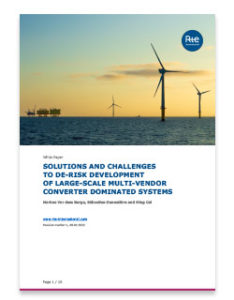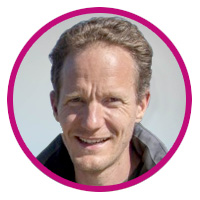How to de-risk large-scale multi-vendor HVDC systems – lessons from the North Sea Wind Power Hub project
Free live webinar
Summary
HVDC-based offshore transmission systems including hub and artificial island concepts are part of future scenarios to master the energy transition in Europe. But what is the status of these projects, what are ongoing developments and how is it possible to systematically de-risk these type of projects?
Multivendor, multiterminal HVDC, massive scale and complexity are some of the examples and keywords that pose enormous challenges for the European network operators, project developers, and engineers. RTE international’s webinar, in collaboration with Energinet, aims to discuss the following questions:
- What are upcoming HVDC projects and developments and what is the status of some exemplary projects?
- What are the key challenges and potential risks of such projects?
- What could be the role of the HIL-setup with C&P replicas for systematically de-risking the process?
Description
In order to meet the Paris Climate Goals and taking into account that offshore wind energy is one of the key building blocks for the green transition of Europe, the European Commission published the EU Offshore Renewable Energy Strategy in November 2020. The strategy aims to develop 300 GW of offshore wind, complemented by 40 GW of other offshore energy technology, by 2050. Established in 2017 and incentivized by the 2050 offshore wind energy capacity target set by the European Commission, the North Sea Wind Power Hub (NSWPH) consortium has been actively engaged in seeking a solution to accelerate the energy transition in Europe by working towards carrying out the first offshore wind power hub project in the early 2030s. The NSWPH consortium envisages adopting the hub-and-spoke concept for the offshore wind power hub development, with the interconnected hubs spanning across country frontiers and integrating different energy sectors and carriers.
Since this ambitious project would involve offshore wind and HVDC technology from different manufacturers and its development would be carried out gradually and modularly in several phases over a long time span, questions are being raised with regard to the particular technical challenges of the project. The principal question being asked is how to effectively de-risk the design of the NSWPH and similar projects to ensure stable grid operation.
In particular, the use of the hardware-in-the-loop (HIL) setup with control and protection (C&P) replicas from different HVDC and OWF vendors in the de-risking process draws a great deal of interest from stakeholders to de-risk such projects. Thanks to their extensive experience acquired from working with C&P replicas in past and on-going projects involving multi-vendor applications, as well as their active contribution to various Cigré working groups on this topic, RTE international will report on de-risking the design and operation of these type of HVDC projects using the HIL setup with real-time simulation and the C&P replicas.
Practical informations
| When | 8 February 2022, 4pm CET |
| Duration | One hour and a half |
Register to learn more about
- Upcoming HVDC projects and their contribution to the energy transition
- Ongoing European developments and challenges in the HVDC market
- Challenges of HVDC projects and how to de-risk and approach these tasks
White Paper

Speakers

Laurids Dall
Senior Power System Engineer at Energinet
Laurids Dall is a power system engineer at the Danish Transmission System Operator, Energinet, where he is working on power system control and stability and integration of large-scale renewable energy. He is the technical lead for electrical system analysis on the Danish Energy Island projects, and has been engaged in the NSWPH consortium since 2019. Laurids Dall holds a M.Sc. degree in Electrical Power System and High Voltage Engineering from Aalborg University, Denmark.

Ming Cai
HVDC Expert at RTE international
Ming Cai received his B. A. Sc in 2008, and M. A. Sc degrees in electrical engineering at the University of British Columbia in 2011. In 2019, he received his Ph.D degree in electrical engineering at Polytechnique Montréal, Canada. He joined RTE international in the same year and is currently involved in projects of electromagnetic transient studies as a technical expert. Ming is in charge of various real-time laboratories and offline studies for Equinor’s project Johan Sverdrup.

Sébastien Dennetière
Senior HVDC Expert at RTE international
Sébastien Dennetière has a decade of experience in HVDC matters and almost two in electrical engineering. He can give expert support to HVDC projects in areas ranging from planning to maintenance. He is active in several professional associations, such as CIGRE, IEEE, and IEC.
In January 2010, he joined the French TSO RTE (Réseau de Transport d’Electricité) where he is currently involved in the power system simulation and HVDC project as a technical expert. One of his main tasks is to integrate HVDC/FACTS equipment to the French grid. He oversees the technical coordination of studies performed for HVDC integration in France and abroad. He was responsible for the development of detailed HVDC and wind turbine models in Uruguay, as well as the development of specifications for coordination of the 2 HVDC systems in Norway for the project “Equinor Johan Sverdrup VSC multivendor interoperability”.
From 2004 to 2008, he worked at the research center of EDF in the field of insulation co-ordination and power system simulations. From 2002 to 2004, he worked at IREQ (Hydro-Québec) on research and development activities related to the simulation and analysis of electromagnetic transients.
Sébastien Dennetière graduated from the École Supérieure d’Electricité (Supélec) France in 2002. He received his M.Sc. degree and PhD degree from the École Polytechnique de Montréal in 2003 and 2017, respectively.
About the North Sea Wind Power Hub (NSWPH)
The consortium of the North Sea Wind Power Hub programme has joined forces to achieve climate goals. The consortium’s work is based on research, stakeholder interaction, and experience from earlier projects. Partners in the consortium are Energinet, Gasunie, and TenneT.
